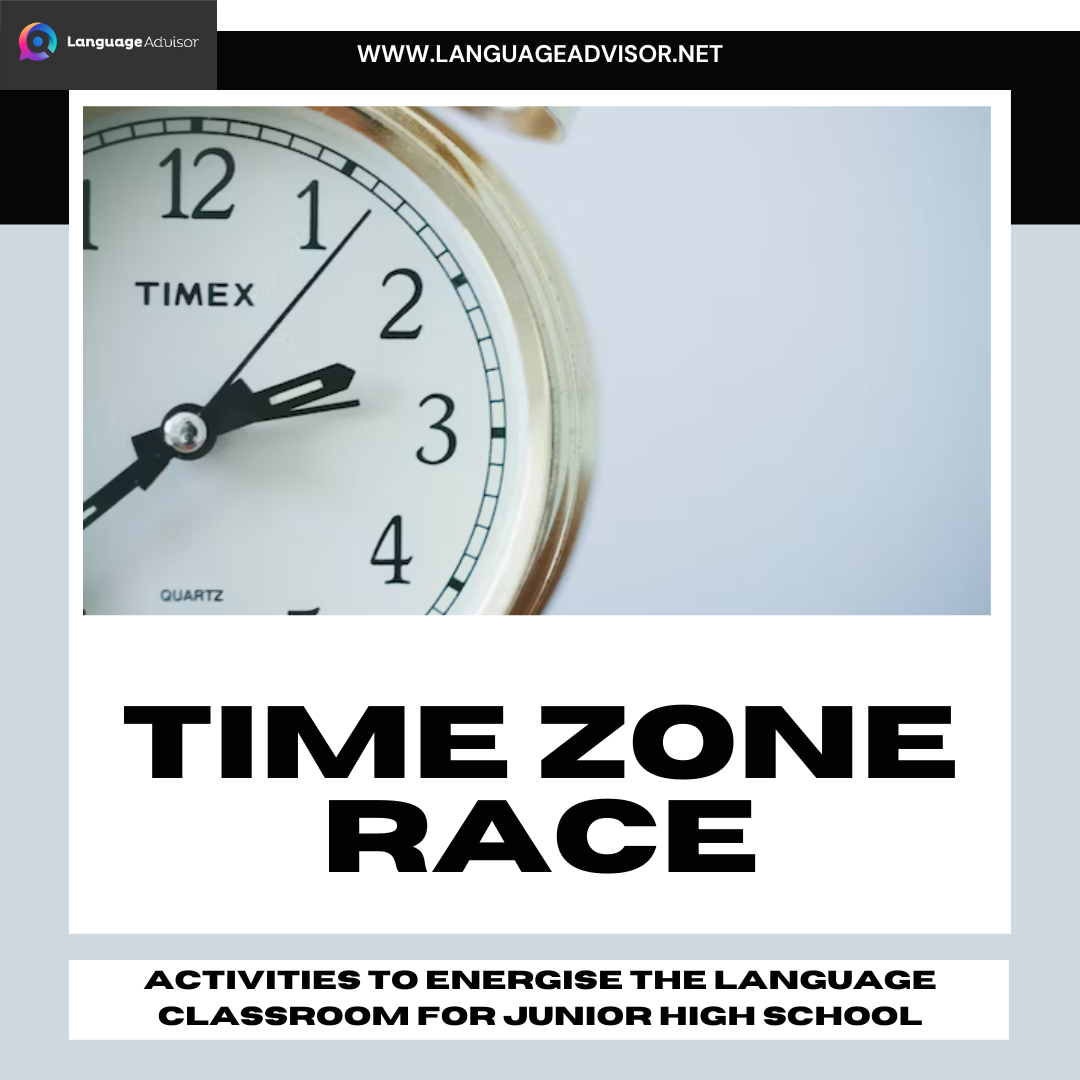TIME ZONE RACE. Games and Activities to Energise the Language Classroom for Junior High School
TIME ZONE RACE

Energising Language Classroom Activities for Junior High School: A Teacher’s Guide
Junior high school students often find language classes challenging, but as a language teacher, you have the power to transform these challenges into engaging learning experiences. Classroom activities are the key to achieving this transformation. These activities not only make learning enjoyable but also foster a deeper understanding of the language, leading to improved fluency and proficiency. In this blog post, we will explore a diverse range of innovative and interactive language classroom activities designed specifically for junior high school students. Whether you’re looking to enhance vocabulary retention, boost conversational skills, or make grammar lessons more enjoyable, this guide will provide you with a rich array of strategies to create a dynamic and effective learning environment for your students. Let’s embark on this journey to energize your language classroom and inspire your students to become passionate language learners.

TIME ZONE RACE
Target Group: 3rd year
Difficulty Level: Basic Conversation
Activity Objective: It is intended for a two-fold goal : explicitly, the students used present tense and the future tense as well as calculated time differences, while implicitly they learned about the effect time zones have when travelling around the world.
TIME ZONE RACE – Procedure
- Arrange the students in groups. Pass each group a time zone map and a set of instructions.
- Set up the premises for the activity. Answer any questions and translate more difficult words if necessary.
- Practice the two target questions with the class: “What time is it in (name of city) now?” and “When will you arrive in (name of city)?”, as well as grammatically appropriate questions to the questions.
- The goal is to finish as many assignments as possible. When a group has an answer, they will send a representative to report to the teacher. The teacher will ask the target questions, and the representative will respond as practiced. If correct, the group will be given the next assignment. There are 10 assignments in total.
Materials and Preparation
- Several copies of a world map with highlighted time zones, with famous cities’ names in easy-toread print.
- 10 envelopes with basic instructions:
● Up to envelope #5: Students are asked to call another country and report the local time when the call will be received. Envelopes #1-5 should state : “Please call (name of city) at (your choice of time).” The time should be given in local Japanese time (GMT+9). Example: “Please
call Dehli at 4:00 PM”
● From envelope #6 onwards: Students receive a promotion, and are asked to fly to another country, stating their arrival in local time after accounting for both time zones and the number of hours spent en-route in the plane. Envelopes #6-10 should state : “Please fly from Tokyo to (name of city). You will depart at (your choice of time, given in local Japanese time). The flight will take (#) hours.” Example: “Please fly to Seoul. You will depart at 9:00 AM. The flight will take 2 hours.”
An interesting premise for this activity is to capture the general students’ initial interest. For example:
“Today, for this one class, you are not junior-high students. You have a new job in a global company, (company of your choice). Your first job is to call other (company of your choice) offices around the world. But, we are very busy people. So, we will only give you a message with your assignment. Please read the message and report back to us with the correct time.”
Suggestions and Advice
An enthusiastically-presented introduction for this activity is essential to sustaining student interest.
There are usually active participants and inactive participants in every class; by combining math and English (particularly in the second set of envelopes), this activity encouraged those students with other academic strengths to participate.
Another way to encourage participation by every member of the class is to make the rule that the representative reporting to the teacher must change to another member of the group after each assignment.
Most junior-high students in Japan have very little experience with calculating time differences, even though they should already know about time zones. Take the time to point out in the beginning where Japan is, and what GMT+9 means in relation to GMT +8(Korea).

Energising Language Classroom Activities for Junior High School
In the world of language teaching, fostering a love for learning and effective communication is our ultimate goal. By implementing these engaging classroom activities for junior high school students, you are not only enhancing their language skills but also creating an environment where curiosity, creativity, and enthusiasm thrive. As we wrap up our exploration of these energizing language activities, remember that your role as a teacher is invaluable, and your dedication to making language learning exciting and impactful is what sets the stage for your students’ future success.
So, continue to innovate, adapt, and personalize these activities to suit the unique needs and interests of your students. Watch as their confidence soars, their vocabulary expands, and their ability to communicate fluently grows. With your guidance and these engaging activities in your teaching toolbox, you are well on your way to inspiring a new generation of confident and capable language learners. The journey to language proficiency may be challenging, but with your passion and these activities, it is always an exciting one.
Happy teaching!

Also check out these articles on teaching, teaching methods and teaching tools












